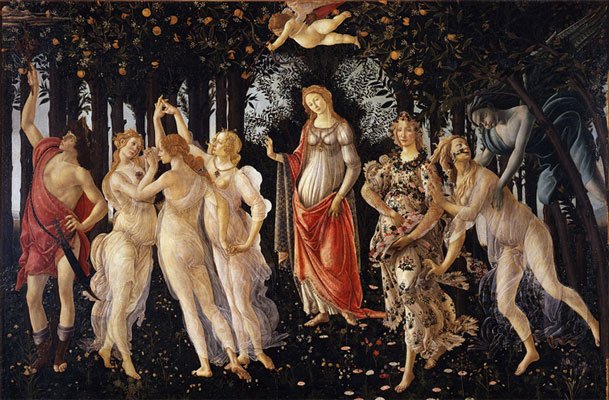Italian painter of the Early Renaissance, Sandro Botticelli, was born at Florence in 1444 in a house in the Via Nueva, Borg' Ognissanti. This was the home of his father, Mariano di Vanni dei Filipepi, a struggling tanner.
A return made in 1457 by his father describes Sandro as aged thirteen, weak in health, and still at school (if the words "sta al legare" are to be taken as a misspelling of "sta al leggere", otherwise they might perhaps mean that he was apprenticed either to a jeweller or a bookbinder).
Botticelli's real name was Alessandro Filipepi. He became known as Botticelli when he went to live with his older brother, Botticello.
Botticelli trained, probably, under Filippo Lippi (c.1458), and from c.1470 worked from his own studio.
He is best known for his treatments of mythological subjects, notably Primavera (Spring) and Birth of Venus, both in the Uffizi.
Venus and Mars painted by Sandro Botticelli in around 1485, shows the Roman gods Venus, goddess of love, and Mars, god of war, in an allegory of beauty and valor. Probably intended to commemorate a wedding, the work was likely set into paneling or a piece of furniture to adorn the bedroom of the bride and groom.
Botticelli's work included illustrations for Dante's Divine Comedy, which he executed in pen and ink and silverpoint.
Among his numerous devotional paintings were the Coronation of the Virgin and the large circular Madonna and Child.
In 1481 Pope Sixtus IV asked Botticelli to help decorate the Sistine Chapel at the Vatican. Internal evidence shows that Sandro and his assistants bore a chief share in the series of papal portraits that decorate the niches between the windows.
There are 500 identified plant species depicted in Boticelli's painting Primavera (see below).
Botticelli never married and is believed to have had an unrequited love for a married woman, Simonetta Vespucci, who was part of Amerigo Vespucci's family. (America was named after Amerigo Vespucci.) She served as the model for his Birth of Venus and recurs throughout his paintings
In Botticelli's later years was much influenced by the teaching of Girolamo Savonarola, who in 1497 organised a “bonfire of the vanities” at the carnival celebration before Lent, in which Florentine luxury goods, works of art, pornographic books and gambling equipment were publicly burnt. Botticell himself destroyed some of his earlier mythological paintings, feeling that when they were painted, he was unduly influenced by the worldly spirit of the age.
Sandro Botticelli died on May 17, 1519, a lonely man having done little or no more painting in his final ten years. He was buried next to his adored Simonetta Vespucci. It was not until over 350 years after his death that the world recognized his importance in art.
Sources K12, Nndb.com
A return made in 1457 by his father describes Sandro as aged thirteen, weak in health, and still at school (if the words "sta al legare" are to be taken as a misspelling of "sta al leggere", otherwise they might perhaps mean that he was apprenticed either to a jeweller or a bookbinder).
Botticelli's real name was Alessandro Filipepi. He became known as Botticelli when he went to live with his older brother, Botticello.
Botticelli trained, probably, under Filippo Lippi (c.1458), and from c.1470 worked from his own studio.
 |
| Self-portrait of Botticelli, in his Adoration of the Magi (1475) |
He is best known for his treatments of mythological subjects, notably Primavera (Spring) and Birth of Venus, both in the Uffizi.
Venus and Mars painted by Sandro Botticelli in around 1485, shows the Roman gods Venus, goddess of love, and Mars, god of war, in an allegory of beauty and valor. Probably intended to commemorate a wedding, the work was likely set into paneling or a piece of furniture to adorn the bedroom of the bride and groom.
 |
| Venus and Mars |
Botticelli's work included illustrations for Dante's Divine Comedy, which he executed in pen and ink and silverpoint.
Among his numerous devotional paintings were the Coronation of the Virgin and the large circular Madonna and Child.
 |
| Madonna and Child with St. John the Baptist, c. 1470–1475, Louvre |
In 1481 Pope Sixtus IV asked Botticelli to help decorate the Sistine Chapel at the Vatican. Internal evidence shows that Sandro and his assistants bore a chief share in the series of papal portraits that decorate the niches between the windows.
There are 500 identified plant species depicted in Boticelli's painting Primavera (see below).
Botticelli never married and is believed to have had an unrequited love for a married woman, Simonetta Vespucci, who was part of Amerigo Vespucci's family. (America was named after Amerigo Vespucci.) She served as the model for his Birth of Venus and recurs throughout his paintings
In Botticelli's later years was much influenced by the teaching of Girolamo Savonarola, who in 1497 organised a “bonfire of the vanities” at the carnival celebration before Lent, in which Florentine luxury goods, works of art, pornographic books and gambling equipment were publicly burnt. Botticell himself destroyed some of his earlier mythological paintings, feeling that when they were painted, he was unduly influenced by the worldly spirit of the age.
Sandro Botticelli died on May 17, 1519, a lonely man having done little or no more painting in his final ten years. He was buried next to his adored Simonetta Vespucci. It was not until over 350 years after his death that the world recognized his importance in art.
Sources K12, Nndb.com

No comments:
Post a Comment